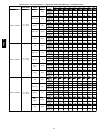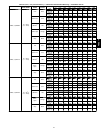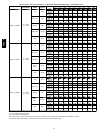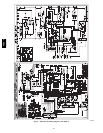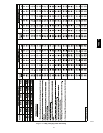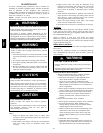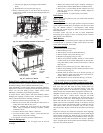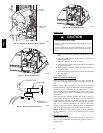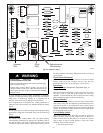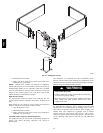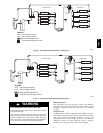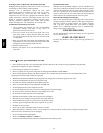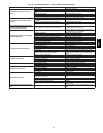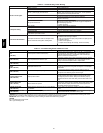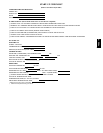
30
BLOWER
HOUSING
2 SETSCREWS
(HIDDEN)
C99085
Fig. 20 -- Removal of Motor and Blower Wheel
A07680
Fig. 21 -- Burner Rack Removed
FEEDER TUBE
STUB TUBE
DEFROST
THERMOSTAT
C99029
Fig. 22 -- Defrost Thermostat Location
A07680
Fig. 23 -- Burner Rack Removed
Outdoor Fan
UNIT OPERATION HAZARD
Failure to follow this caution may result in damage to unit
components.
Keep the outdoor fan free from all obstructions to ensure
proper cooling operation. Never place articles on top of the
unit.
CAUTION
!
1. Remove 6 screws holding outdoor grille and motor to top
cover.
2. Turn motor/grille assembly upside down on top cover to
expose the fan blade.
3. Inspect the fan blades for cracks or bends.
4. If fan needs to beremoved, loosen the setscrew and slide the
fan off the motor shaft.
5. When replacing fan blade, position blade back to the same
position as before.
6. Ensure that setscrew engages the flat area on the motor shaft
when tightening.
7. Replace grille.
Electrical Controls and Wiring
Inspect and check the electrical controls and wiring annually. Be
sure to turn off the gas supply, and then the electrical power to the
unit.
Remove access panels (see Fig. 19) to locate all the electrical
controls and wiring. Check all electrical connections for tightness.
Tighten all screw connections. If any discolored or burned
connections are noticed, disassemble the connection, clean all the
parts, re--strip the wire end and reassemble the connection properly
and securely.
After inspecting the electrical controls and wiring, replace the
access panels (see Fig. 19). Start the unit, and observe at least one
complete heating cycle and one complete cooling cycle to ensure
proper operation. If discrepancies are observed in any operating
cycle, or if a suspected malfunction has occurred, check each
electrical component with the proper electrical instrumentation.
Refer to the unit wiring label when making these checkouts.
NOTE: Refer to the heating and/or cooling sequence of operation
in this publication as an aid in determining proper control
operation.
Refrigerant Circuit
Annually inspect all refrigerant tubing connections and the unit
base for oil accumulations. Detecting oil generally indicates a
refrigerant leak.
48EZ --A



